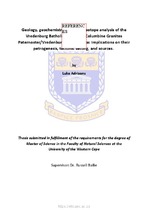| dc.description.abstract | The late− to post−collisional Cape Granite Suite (CGS) located in the southwest of South Africa is
comprised of S−, I−, and A−type granites, mafic intrusives, and volcanic flows. The CGS is interpreted
to have formed during the closing of the Adamastor Ocean during the Late−Proterozoic to
Early−Cambrian. Recently, the S−type granites have received much attention concerning their
petrogenesis and sources. However, the I− and A−type granites remain poorly understood and little
studied. Therefore, with new geochemical and isotopic data the petrogenesis, sources, and tectonic
settings of I− (Vredenburg Batholith) and A−type (Cape Columbine) granites of the CGS form the focus
for this study.
The major and trace element data presented in this thesis show that the granites from the Vredenburg
Batholith are weakly peraluminous to metaluminous, ferroan, and alkali−calcic. Associated with the
granites are metaluminous, magnesian, and calc−alkalic igneous enclaves. Formerly, the granites have
been interpreted to have formed by fractionation. However, with new geochemical analyses and reassessment
of such models, it can be shown that such processes are incompatible with accounting for
the chemical variation displayed by the granites and their enclaves. Moreover, the I−type granites and
enclaves exhibit positive linear trends between whole−rock major and trace elements vs. maficity (Fe +
Mg), which can be explained by co−entrainment of peritectic and accessory phases. The
lithogeochemical characteristics of the enclaves and host granite reflect melting of a heterogeneous
source. Moreover, the granite and enclave's εNd(t) values reflect melting of Paleoproterozoic-aged
crustal sources. Finally, with tectonomagmatic discrimination diagrams, it can be shown that the
tectonic setting of the granites indicates a transition from a collisional to extensional regime which
corroborates the inferences of previous studies.
The Cape Columbine Granites lithogeochemical characteristics are ferroan, calc−alkalic and weakly
peraluminous. They show typical A−type granite characteristics in having high silica content, high Na +
K values, REE enrichment as compared to S− and I−type granites and strong negative Eu anomalies.
For this thesis, it can be shown that anatexis of quartzofeldspathic protolith in an extensional regime
produced the chemical variation of the Cape Columbine Granite. Moreover, their isotope ratios are
typically radiogenic, indicative of a crustal origin. With this new geochemical data evidence is provided
against and in support of previous inferences made about the petrogenesis of the I− and A−type
granites of the CGS. This also betters our understanding of the magmatic processes involved in the
construction of the CGS over time. | en_US |

